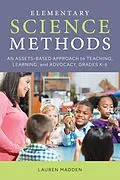As teachers and parents, we often hear that children are the best scientists. Great science teachers tune in to children's interests and observations to create engaging and effective lessons. This focus on the innate curiosity of children, or humans overall is celebrated and used to justify and support efforts around STEM teaching and learning. Yet, when we discuss elementary school teachers, we often hear many inside and outside the classroom report that these teachers dislike, fear, and feel uncomfortable with science. This is exactly the opposite approach from what is universally recommended by science education scholars. This practical textbook meets the immediate, contextual needs of future and current elementary teachers by using an assets-based approach to science teaching, showing how to create inquiry-based lessons, differentiate instruction and lesson design based on children's developmental ages and needs, and providing easy-to-use tools to advocate for scientific teaching and learning guided by the Next Generation Science Standards (NGSS).
Autorentext
Lauren Madden is associate professor of Elementary and Early Childhood Education at The College of New Jersey, where she teaches undergraduate and graduate science teaching methods courses and degree capstone courses. She has published science education articles in many peer-reviewed journals, including Journal of Science Teacher Education, Science and Children (NSTA), Journal of Early Childhood Teacher Education, Research in Science Education, Environmental Education Research, CITE Journal (Society for Information Technology and Teacher Education), and International Journal of Science Education. Her research interests include scientist-educator collaboration, intersections of Next Generation Science Standards and Common Core Curriculum Standards, preservice teacher perspectives and attitudes on STEM education, and the uses of interactive science notebooks.
Inhalt
Table of Contents
Forward
Chapter 1 An Introduction to Assets-Based Elementary Science Teaching
Chapter 1 Supplementary Lesson: Cookie Chemistry Lesson
Chapter 2 A Developmental Perspective on Science Teaching and Learning
Chapter 3 Inquiry-based Teaching- Connecting Theory to Strategy
Chapter 4 What is (& isn't) science anyway?
Chapter 5 The Next Generation Science Standards- an Introduction
Chapter 6 Asking Good Questions & Developing Lessons
Chapter 6 Supplementary Lesson: Termite Trails Lesson
Chapter 7 Connecting Science to Language Arts & Mathematics
Chapter 7 Supplementary Lesson A: Horseshoe Crab Lesson
Chapter 8 STEM & STEAM- Creativity and Problem-Solving in Elementary Science
Chapter 8 Supplementary Lesson: Ride or Diatom Lesson
Chapter 9 Beginning to Use Science to Advocate
Chapter 10 Equity, Diversity, and Inclusion in Science Teaching
Chapter 11 How do we know what we know in science?
Chapter 12 Science Outside of School
Chapter 13 Advocating for Science
Glossary
